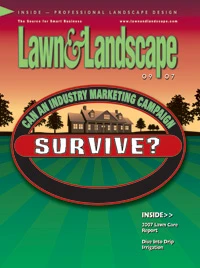Landscape designers enjoy an unprecedented wealth of plants to choose from in the quest to bring clients the perfect landscapes. But recently, some designers have chosen sides and believe that native plants are better plants.
In the sometimes-heated discussion about native plants in the landscape, it is important to define terms. The very definition of what is “native” is elusive and is not always agreed upon. Designers should consider the problems and benefits of both native and exotic species and the role should the site should play in the decision about what to plant.
NATIVE VS. EXOTIC. We generally depend on local floras, inventories of the uncultivated plant life of a given region, to tell us which plants are native. However, these inventories are sometimes flawed and are subject to continual debate. Only fossil records can prove that a plant evolved in a certain place, and even these can be misinterpreted. If we arbitrarily pick a point in time and say “plants in this place before this date are native,” we may not be acknowledging that for centuries, indigenous peoples, explorers and botanists have had an impact on regional floras with their activities.
Geopolitical and ecological boundaries also play a role in defining native plants. To say a plant is “native to North America” or “native to New York State” implies that it is suitable for growth throughout North America or New York State, when in fact it may only occur naturally in limited microclimates or regions and thus only be suitable for growth in equally limited landscape situations. Ecotypes are plants of the same species that are found in different habitats and have evolved specific adaptations to their differing environments. Red maple, for example, is native from Florida to Canada, but populations have adapted to dry or wet sites, cold or warm climates. Although red maple is technically native to a large section of North America, seed harvested from one ecotype will not necessarily perform successfully in another site because it is not adapted to the new site’s conditions.
Exotic plants, also known as non-native, introduced or alien plants, are species that occur in cultivation or in the wild and were transported across boundaries over time.
One-fifth to one-third of the plant species encountered north of Mexico have their origins in other continents, according to The Flora of North America. Many exotic plant introductions, such as lily-of-the-valley, daylilies and daffodils, have become naturalized, meaning that they have succeeded in reproducing and spreading to a limited extent on their own. Unlike invasive plants, however, most naturalized plants are not a severe threat to other species or to an ecosystem. In fact, a small percentage of naturalized exotic plants become invasive, or those plants that reproduce quickly, displace many of the other species in their domain and are difficult to eradicate. Purple loosestrife in the northern U.S. and kudzu in the southern states are classic examples of invasive plants that greatly affect the landscape.
PLANT SELECTION — NATIVE OR EXOTIC? One main reason people promote native plants is to avoid the damage that invasive plants may bring. Why do a small percentage of plants exhibit invasive tendencies, while the majority of plant introductions are benign or beneficial? The answer lies in the combination of two factors: traits that invasive plant species share and traits of the site that make it susceptible to invasion. No plant is inherently invasive and native plants also can become invasive. Native grape vines like fox grape form thickets over shrubs and rapidly climb trees, threatening to out-compete their hosts for light. Though native to parts of North America, wild grape is an indisputable pest.
Another factor is the interaction of native plants with the non-native environment. In an urban setting, for example, there is no planting site that is equal to what would have been there prior to urbanization. To put a native tree on a median strip planting on a downtown street because it is native to the surrounding countryside would be foolhardy unless the tree is known to tolerate asphalt heat, car exhaust, salt from the snowplows, a limited root zone, intermittent flooding and periodic drought.
NOT EITHER/OR. If native plants are used simply because they are native, without proper regard to site conditions, the results may be unsatisfactory. The most critical issue is not native vs. exotic – it is appropriate vs. inappropriate plant selection, given the constraints and opportunities of the site in mind. The more closely a plant’s characteristics match the site’s, the better chance for its survival and vigor.
In the quest for a diverse, healthy landscape, which may be a mix of native and exotic species, a little research before selecting plants can save time, money and aggravation. Reference guides may warn that a plant is invasive under certain circumstances, but they may not, and nursery catalogs frequently won’t. Phrases like “a very vigorous grower” can be euphemisms for potential invasiveness. Treat such phrases as red flags.
Be sure to look in more than one reference to gather more than one perspective on any species you have in mind, especially if you suspect it may be invasive. After invasive potential is ruled out, the physical limitations and possibilities of the site should be the first and most important consideration in the exciting process of selecting new plants for our landscapes.
The authors are with The Urban Horticulture Institute, Department of Floriculture and Ornamental Horticulture, Cornell University.

Explore the September 2007 Issue
Check out more from this issue and find your next story to read.
Latest from Lawn & Landscape
- ExperiGreen, Turf Masters Brands merge
- EquipmentShare cuts ribbon on new Maryland branch
- Strathmore acquires Royal Tree Service in Montreal
- In a new direction
- The December issue is now live
- Ignite Attachments debuts 80-inch, severe-duty bucket
- EquipmentShare breaks ground on Roswell branch
- NaturaLawn of America adds Schwartz, Medd to operations team





